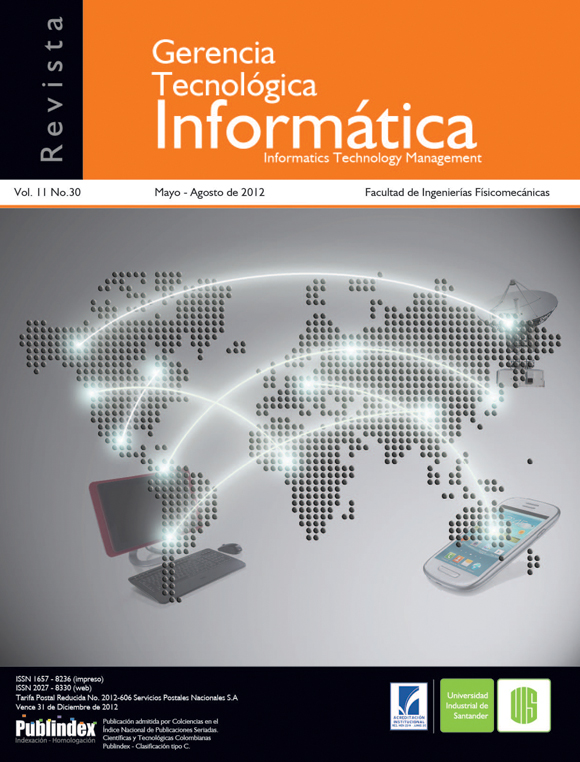Artículos de Investigación Científica e Innovación
ANALISIS COMPARATIVO DEL DESEMPEÑO DE LOS ALGORITMOS FSD Y QRD-M EN SISTEMAS MIMO 4X4
Published 2013-01-25
How to Cite
Muñoz C., C., Muñoz, T., & Hernández, C. M. (2013). ANALISIS COMPARATIVO DEL DESEMPEÑO DE LOS ALGORITMOS FSD Y QRD-M EN SISTEMAS MIMO 4X4. Revista GTI, 11(30), 25–36. Retrieved from https://revistas.uis.edu.co/index.php/revistagti/article/view/2976
Abstract
Los sistemas de comunicaciones de Múltiples Entradas y Múltiples Salidas (MIMO, Multiple-InputMultiple-Output) son uno de los pilares de las altas capacidades de transmisión de datos, ofrecidas
por los sistemas de comunicación de tercera y cuarta generación. Una de sus etapas más críticas es
el proceso de detección, por ello este artículo presenta un análisis comparativo del desempeño de
los algoritmos Decodifcador Esférico de Complejidad Fija (FSD, Fixed-complexity Sphere Decoder) y
Descomposición QR con M-algoritmos (QRD-M, QR Decomposition-M), empleados en la detección
en sistemas MIMO. Para ello se realiza un estudio detallado de las generalidades del sistema MIMO,
y se sigue una metodología que permite abordar el problema de la detección, desde una concepción
analítica para después modelarlo en un sistema computacional. Los sistemas MIMO cuentan con
múltiples antenas de transmisión y recepción, estos emplean esquemas de multiplexación para
mejorar la comunicación, con el inconveniente de que los símbolos se interferen en el receptor, por
lo que se requieren algoritmos de detección de señales que permitan detectar los símbolos enviados, entre los cuales se encuentran los algoritmos FSD y QRD-M, estos son analizados y simulados en Matlab para comparar su desempeño, con el fn de determinar el algoritmo adecuado a implementar en un sistema MIMO determinado. En la metodología para el desarrollo de la simulación, se defnen los parámetros de los algoritmos, el diagrama de bloques del sistema y los escenarios de simulación, para así realizar el análisis de desempeño. En el análisis de los resultados, los algoritmos FSD y QRD-M se comparan con el algoritmo Máxima Verosimilitud (ML, Maximum Likelihood), el desempeño se determina mediante la comparación de las curvas de Tasa de Error de Bit (BER, Bit Error Rate) vs. Relación Señal a Ruido (SNR, Signal to Noise Ratio) y la complejidad computacional de cada algoritmo.
Downloads
Download data is not yet available.
References
- GESBERT, David, et al. From Theory to Practice: An Overview of MIMO Space–Time Coded Wireless Systems. IEEE Journal on Selected Areas in Communications. vol. 21,no.3, Abril 2003. pp. 281- 302.
- SANAYEI, Shahab y NOSRATINIA, Aria. Antenna Selection in MIMO Systems. IEEE Communications Magazine, vol. 42, Octubre 2004. pp. 68-73.
- SHARIAT-YAZDI, Ramin y KWASNIEWSKI, Tad. Configurable K-best MIMO Detector Architecture. En: 3RD INTERNATIONAL SYMPOSIUM ON COMMUNICATIONS, CONTROL, AND SIGNAL PROCESSING (ISCCSP). St Julians, Malta. 2008. pp. 1565-1569.
- LARSSON, Erik. MIMO Detection Methods: How They Work. IEEE signal processing Mag. vol. 26, Mayo 2009. pp. 91-95.
- MATTHAIOU, Michail, et al. Reduced Complexity Detection for Ricean MIMO Channels Based on Condition Number Thresholding. En: 2008 INTERNATIONAL WIRELESS COMMUNICATIONS AND MOBILE COMPUTING CONFERENCE. Grecia. 2008. pp. 988-993.
- ROMANO, Gianmarco, et al. A tree-search algorithm for ML decoding in underdetermined MIMO systems. En: PROCEEDINGS OF THE 2009 6TH INTERNATIONAL SYMPOSIUM ON WIRELESS COMMUNICATION SYSTEMS. Italia. 2009. pp. 662- 66.
- ROGER, Sandra. et al. Recent Advances in MIMO Wireless Systems. En: 9TH INT. CONF. MATHEMATICAL AND NUMERICAL ASPECTS OF WAVES PROPAGATION. 2009.
- OUERTANI, Rym y BEN-OTHMAN, Ghaya. Hard and Soft Spherical-Bound Stack decoder for MIMO systems (Online). Noviembre 2008. http://arxiv. org/abs/0811.1000
- ELSHOKRY, Auda. Complexity and Performance Evaluation of Detection Schemes for Spatial Multiplexing MIMO Systems. Gaza, 2011, Tesis de Maestria. Universidad Islamica de Gaza. Departamento de Ingenieria.
- MOHAISEN, Manar Detection Techniques for MIMO Multiplexing: A Comparative Review. KSII transactions on internet and information systems, vol. 3, no.6, Diciembre 2009. pp. 647-666.
- BARBERO, Luis y THOMPSON, John. Performance Analysis of a Fixed-Complexity Sphere Decoder in High-Dimensional MIMO Systems. En: IEEEInt. Conf. Acoustics, Speech and Signal Processing Proc.. Francia. 2006. pp. 4-7.
- LIU, L. et al. An Iterative QRD-M Detection Algorithm for MIMO Communication System. En: PROGRESS IN ELECTROMAGNETICS RESEARCH SYMP. China. 2009.
- CHIN, W. QRD Based Tree Search Data Detection for MIMO Communication Systems. En: IEEE 61ST VEH. TECHNOLOGY CONF. PROC. 2005.
- MOHAISEN, Manar y CHANG, KyungHi. On Improving the Efficiency of the Fixed-Complexity Sphere Decoder. En: PROC. 2009 IEEE 70TH VEHICULAR TECHNOLOGY CONFERENCE FALL. 2009. pp 1-5.
- BARBERO, Luis y THOMPSON, John. Fixing the Complexity of the Sphere Decoder for MIMO Detection. IEEE Trans. Wireless Communications, vol. 7, no. 6, Jun. 2008. pp. 2131-2008.
- BARBERO, Luis y THOMPSON, John. Extending a Fixed-Complexity Sphere Decoder to Obtain Likelihood Information for Turbo-MIMO Systems. IEEE Trans. Vehicular Technology, vol. 57, no. 5, Sep. 2008. pp. 2804-2814.
- ASTAIZA, Evelio, et al. Simulación de Sistemas de Telecomunicaciones. Padilla Bejarano. 2007.
- GUEREQUETA, Rosa y VALLECILLO, Antonio. Técnicas de Diseño de Algoritmos (Online). 1998 (citado Enero de 2012) http://www.lcc.uma. es/~av/Libro/indice.html
- PEÑA, Daniel. Análisis de Datos Multivariantes. McGraw-Hill, 2004.
